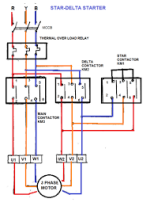tim_callinan
Member
OP
Hi Folks,
Thank you for all the feedback. We're planning on having an adjunct electrical engineer who does this stuff at work everyday to teach the course. If we had unlimited dollars and space - I would buy an amatrol motor control trainer but they cost around 50k a trainer. - This is the main reason I'm trying to build 4 double sided trainers. Im including the first 7 labs we're thinking about before we move onto VFDs, HMIs & PLCs. The first 7 labs will be what I would call - old school motor control.
Labs 1-7 here.......
https://www.dropbox.com/s/l8dpw3w7dlnkmad/combinepdf.pdf?dl=0
So from your feedback it seems....
1) Definitely need to remember that the line comes in at the top and the load comes in at the bottom.
2) We need to install a 3phase E-Stop on the side of the trainer.
3) Cover Forward & Reverse interlocking circuits
4) Wye Start - Delta Run motors stuff - This concept seems like it is for very large motors? Would this be called a Soft Starter in the states? I cant seem to find a Wye-Start Delta run motor starter in McMaster-Carr for some reason.
Anyway thanks for all the advice - this is an amazing forum with good people.
Tim
Thank you for all the feedback. We're planning on having an adjunct electrical engineer who does this stuff at work everyday to teach the course. If we had unlimited dollars and space - I would buy an amatrol motor control trainer but they cost around 50k a trainer. - This is the main reason I'm trying to build 4 double sided trainers. Im including the first 7 labs we're thinking about before we move onto VFDs, HMIs & PLCs. The first 7 labs will be what I would call - old school motor control.
Labs 1-7 here.......
https://www.dropbox.com/s/l8dpw3w7dlnkmad/combinepdf.pdf?dl=0
So from your feedback it seems....
1) Definitely need to remember that the line comes in at the top and the load comes in at the bottom.
2) We need to install a 3phase E-Stop on the side of the trainer.
3) Cover Forward & Reverse interlocking circuits
4) Wye Start - Delta Run motors stuff - This concept seems like it is for very large motors? Would this be called a Soft Starter in the states? I cant seem to find a Wye-Start Delta run motor starter in McMaster-Carr for some reason.
Anyway thanks for all the advice - this is an amazing forum with good people.
Tim
Last edited:




